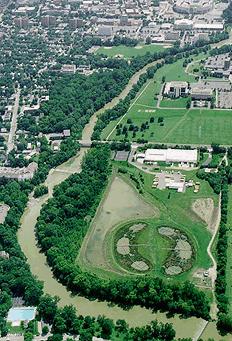
No Proof That Mitigated Wetlands Work
by Holly Wagner
Ohio State
University
 |
by Holly Wagner |
|
 Are
human-made wetlands really as
good as the real thing? It's going to take
scientists more than a dozen years to find out,
according to a researcher at Ohio State
University.
Are
human-made wetlands really as
good as the real thing? It's going to take
scientists more than a dozen years to find out,
according to a researcher at Ohio State
University.
Two experimental wetlands at the university seem to be behaving quite differently -- one is 20 percent more productive than the other, but is far less diverse in terms of plant species. But both seem to contribute equally to reducing nitrates -- chemicals often found in pesticides. "Right now, it seems to be a question of choosing between diversity vs. productivity when constructing a wetland," said William Mitsch, director of the Olentangy River Wetlands Research Park. Six years ago, Mitsch and several volunteers planted about a dozen plant species in one two-and-a-half acre wetland, while letting nature develop the other equally sized wetland. "The unplanted wetland is now producing more biomass," he said. "It produces more peat, which translates to more vegetation, which means denser habitat for wildlife to conceal themselves." Also, more peat may impact the ability of the wetland to filter pollutants. Three years into the experiment, the wetlands had converged -- they were nearly identical in terms of plant species and water filtration. Since then, they have diverged in terms of vegetation. The originally unplanted wetland is now filled with mostly cattails and bulrushes, while the other wetland has about a half-dozen plant species. Yet many of the functions, such as water purification, are similar in both wetlands. "That's why we're waiting 14 more years," Mitsch said. "We want to see if the wetlands converge again or whether the difference in productivity is enough to cause them to diverge in their ability to clean water." Though Mitsch admits that he is unsure where the wetlands are headed, he agrees that time is of the essence, as real estate developers continue to fill in natural wetlands and environmental problems -- such as hypoxia -- seem to worsen. When a developer fills in and builds on a natural wetland, he's required by federal law to create a wetland in a nearby area -- a process called mitigation. And it's the developer's responsibility to maintain and monitor the wetland for five years, according to Mitsch. After five years, though, these mitigated wetlands often "disappear off everybody's radar screen." "And the Army Corps of Engineers wants to know if, after five years, a created or restored wetland functions as a real wetland," Mitsch said. "We just can't draw that conclusion yet." But scientists do know that it will take a phenomenal amount of land -- about 5 million acres -- to create enough wetlands to control the environmental threat of hypoxia in the Gulf of Mexico. Essentially, hypoxia is the depletion of oxygen from a body of water, turning the area into a "dead zone." Each spring, nearly 7,000 square miles of water in the Gulf of Mexico become a dead zone. Mitsch chaired a federal committee that released a report investigating what could be done to stop the flow of nitrates from Midwestern farm fields into the Gulf of Mexico. Wetlands topped the list of alternatives that would allow farming in the Midwest to continue close to how it is practiced today. "The ability to create wetlands provides a marvelous opportunity to solve an enormous environmental problem, and to solve it ecologically, rather than mechanically," Mitsch said. Wetlands are often called the "kidneys" of the landscape. They act as buffer zones, reducing the amount of nitrates and other chemicals in water. "And wetlands do this at a tenth of the cost of a water treatment plant," Mitsch said. Wetlands also serve as a zoo of sorts. "They allow the public to view nature in a real setting, again at a tenth of what it would cost to build an actual zoo," he said. One of the biggest problems with creating wetlands, however, is a lack of education. "Many of the people creating and restoring wetlands aren't formally trained to do so," Mitsch said. He suggests making it mandatory that all wetland scientists receive certification in wetland science before undertaking wetland creation and restoration. Mitsch conducts much of the wetlands project research at the Olentangy River Wetlands Research Park with Virginie Bouchard, a postdoctoral researcher in natural resources at Ohio State. Mitsch, his colleagues and students also conduct regular tours of the wetlands. Mitsch presented six years of wetlands research Feb. 19 in Washington, D.C. at the annual meeting of the American Association for the Advancement of Science.
Albion Monitor
March 19, 2000 (http://www.monitor.net/monitor) All Rights Reserved. Contact rights@monitor.net for permission to use in any format. |